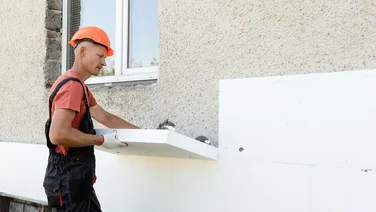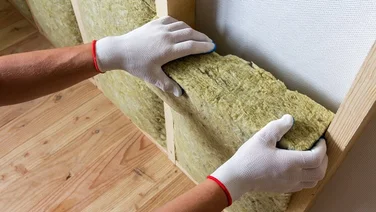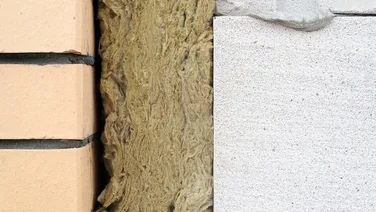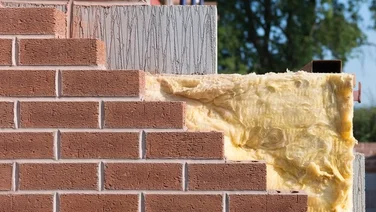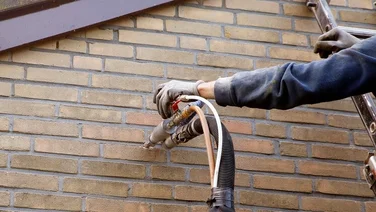We receive a small fee from trusted installers when you request a quote through our site. This helps us keep our content independent, well-researched and up to date – Learn more
- Solid wall insulation can save you up to £410 per year
- It can also stop you from releasing 0.9 tonnes of CO2 per year
- Solid wall insulation usually saves more money than cavity wall insulation
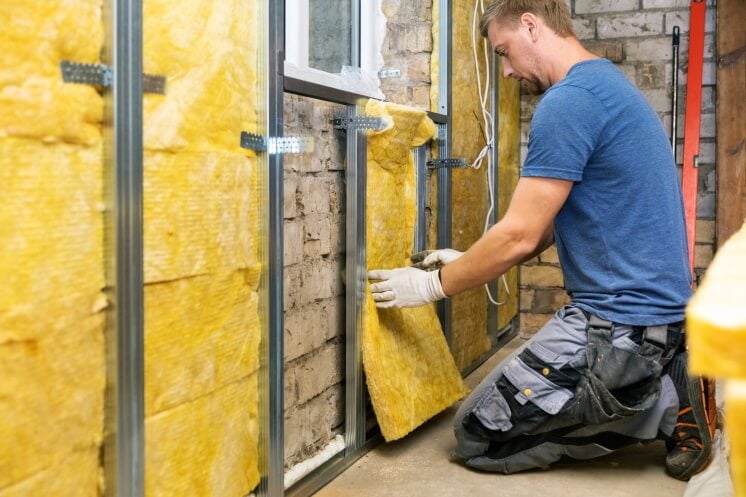
Solid wall insulation costs more than the price of spray foam insulation, but it can save you money and help fight climate change, all at the same time. It’s a win-win – and now’s the time to act.
Insulating solid walls can save you up to £410 per year on energy bills – more than any other kind of wall insulation.
28% of UK properties have solid walls, according to the National Energy Foundation, which means there are potentially millions of homeowners who could save thousands in the short and long term, simply by getting some insulation.
If you’d like to see how much spray foam insulation would cost you, you can fill in this quick form.
Get free insulation quotes
Answer a few quick questions, and our trusted installers will send you bespoke insulation quotes – for free.
What is solid wall insulation?
Solid wall insulation involves attaching a layer of insulating material to either side of a solid wall, which means it can be installed inside or outside your home.
A solid wall is constructed as a single series of bricks or stone, with no cavity – and therefore no room for insulation inside the wall.
If your home was built before the 1920s, it probably has external solid walls, and may also have internal solid walls.
But don’t worry – even if your home remembers the Treaty of Versailles and the suffragette movement, you can still insulate it.
In fact, solid wall insulation is usually more effective at cutting your energy bills than cavity wall insulation.
And if your carbon footprint is on your mind, you’ll be pleased to know that there are various eco-friendly types of insulation on the market.
How does it work?
There are differences between insulating external and internal walls, but the basic principle is the same.
Your installer will attach insulating material to the visible exterior of the wall, before covering it up to ensure that your home’s appearance is not affected.
Internal walls
There are two ways of insulating an internal wall.
A professional may stick rigid insulation boards to your wall, with plasterboard on the outside to make sure it still looks presentable.
Alternatively, they may construct a stud wall filled with insulating material, particularly if you have a problem with damp, or if your wall is uneven. (Rigid boards and stud walls are discussed in more detail lower down the page.)
In both cases, what you’ll see when they’re done is a layer of plasterboard that you can skim and paint in a colour of your choosing.
The process will reduce your floor space, as the insulation is around 10cm thick. This could be exacerbated if the installer decides that a stud wall is best – though it may still be worth it.
Don’t worry if your installer starts taking out your door frames, external fittings, and skirting boards, as this is a necessary part of the procedure. They’ll reattach them at the end.
After the walls are insulated, skimmed, and painted, make sure to acquire special fixings before you hang any paintings or clocks. These walls are no longer made of solid brick alone…
External walls
This will require an installer to attach a layer of insulating material to the wall, then cover it with render or cladding, before adding a finish.
You’ll be able to choose a finish from a variety of options, including smooth, tiled, painted, pebble-dashed, and brick slips. Your home can look however you want it to – and it’ll be warmer, too.
There are plenty of other advantages, too. Getting your external walls insulated will cause less disruption to your day, won’t reduce your floor area, and will make your home more soundproof and weather-resistant.
Your brickwork will also be protected from the elements and therefore last longer, and you should get fewer draughts and less condensation.
If an installer can easily access your external walls, then all you’ll need to do is ask your local council if you’re allowed to go ahead. If they say yes, you’ll be clear to proceed.
Read about the pros and cons of external wall insulation on our page.
Solid wall insulation cost
Solid wall insulation typically costs £11,000 for external walls and £7,500 for internal walls, according to the Energy Saving Trust (EST).
We’d recommend saving money by adding insulation jobs onto other home improvement projects, such as replacing your windows or adding solar panels. This way, you can spread the costs out.
You’ll typically have to pay £100/m² for solid wall insulation, so it’s possible to measure your home and come up with an approximate amount.
Here’s a rough estimate for different types of home, though we would definitely still recommend asking at least three professionals for quotes.
Solid wall insulation savings
Solid wall insulation can save you up to £410 per year on your energy bills, as well as save the planet from enduring as much as 0.9 tonnes of CO2, according to the EST.
The UK is responsible for more than 400 million tonnes of CO2e* per year, according to the latest government data. This works out to 6.2 tonnes per person.
So the idea of saving 15% of that total – and making winters more comfortable for you and your family – sounds pretty great.
And hey, £410 extra in the bank every year isn’t bad either.
Proper insulation for homes is becoming ever more important in the wake of the ongoing energy crisis, which is seeing bills continue to rise. The Eco Experts’ National Home Energy Survey made this clear.
A whopping 60% of Brits want to go greener, according to the survey, and insulation is one of the best ways to make this a reality.
These figures are based on insulating a home that’s heated by gas – which probably includes you, since 85% of homes are saved from the slings and arrows of cold snaps by gas heating, according to government data from 2020.
It’s also worth bearing in mind that insulation can add value to your property, by improving its Energy Performance Certificate (EPC) rating.
A government study from 2013 found that if insulation helps you to move up two EPC rankings, from G to E, this would typically add around £16,000 onto the price of your home.
*carbon dioxide equivalent, a measurement that converts all greenhouse emissions into CO2 terms
Solid wall insulation grants
There’s only one solid wall insulation grant you should look into right now: the government’s Energy Companies Obligation scheme.
Here’s everything you need to know.
Energy Companies Obligation scheme (ECO)
Since it was created in 2013, ECO has compelled companies all over the UK to provide low-income homes and people on certain benefits with heat-saving methods – including solid wall insulation.
If a company is large enough, it’s obliged to install the equivalent of up to 35,000 heating systems per year, and has to ensure that 15% of the households it helps are in rural areas.
You may qualify to use the ECO scheme if you’re on one of a range of benefits, including the Pension Guarantee Credit, Tax Credits, and Universal Credit. The full list is available here.
It’s also worth mentioning the Affordable Warmth Obligation scheme (AWO), which you may encounter while looking for government grants. Don’t be confused – it’s exactly the same as the ECO scheme.
Green Homes Grant
In July 2020, the government announced the £2 billion Green Homes Grant – but it was cancelled a year early, on 31 March 2021.
The scheme was meant to hand £5,000 vouchers to 600,000 homes to help them pay for energy-saving home improvements including solid wall insulation.
The government fell 93.5% short of this goal, thanks to a lack of advertising and a rollout that Greenpeace UK called “shambolic.”You might also like: A Guide to Government Grants for Insulation
Solid wall insulation types
There are many different types of insulation, both in terms of materials and methods. Let’s run through all the most popular options.
Materials
Insulating materials are generally either made out of foam plastics – like polyurethane, polyisocyanurate, and polystyrene – or wool types like fibreglass and mineral wool.
Foam plastics are light, durable, and damp-resistant, but are also flammable – and if they burn, they let off toxic fumes.
Wool types are non-flammable, generally less expensive, and often come with a built-in vapour barrier, which helps to prevent damp.
Internal methods
There are three different methods for insulating the inside of your home, though the first two are certainly more effective.
Rigid insulation boards
These are hard, lightweight rectangles, which an installer will fit onto your wall before covering them in plasterboard. Some even come with the plasterboard pre-attached.
While rigid insulation boards are typically more expensive than other solid wall insulation types, they also provide the highest level of energy efficiency. This also allows them to be thinner, thus taking up less space.
As well as providing thermal insulation, they’ll also make your home more soundproof. Your installer can also incorporate a vapour barrier into them, protecting your home against damp.
They won’t rot, but they are generally flammable, and will produce toxic fumes if they burn.
Stud wall
Your installer will create a stud wall, usually out of wood, against your original wall. It’ll be a frame of your wall, with several thin columns connecting the top to the bottom.
They will then fit one of the insulating materials mentioned above between the gaps, and cover the result in plasterboard.
You may want to choose this option if your wall is rough or uneven, and you’d like it to be generally easier to paint and decorate – though it may be more difficult to hang objects from than the original wall.
Wood is obviously flammable, and taking this route will also reduce your floor area more than other options, but it may be worth it to have a nicer-looking, more insulated wall.
Flexible thermal lining
Flexible thermal lining comes in rolls, and can be stuck to the wall with a special adhesive.
It’s typically not as effective as its two internal counterparts at insulating against… well, anything, but it is usually cheaper. It’s also only around 10mm thick, and easy enough to install by yourself.
If you’re looking for a cheap way to slightly increase your insulation levels, this is a good alternative.
External methods
Your installer will attach insulating material to the outside of your home, and then cover it up with either plasterwork or cladding.
Plasterwork
Plasterwork, or render, is a wet coat of plaster applied to the outside of your home, to give it a smooth appearance after the insulating material is installed.
It’s usually less expensive than cladding, and allows you to paint the wall whatever colour you’d like – an opportunity which cladding does not generally offer.
Alternatively, you could add pebbledash (a slurry of sand, gravel, and sometimes pebbles and shells) to the plasterwork, to change the look of your home and make it more durable and resistant to wear and tear.
Cladding
This is a dry material that your installer will attach to your external wall with fittings or screws.
Choices range from wood to corrugated iron and brick slips, which gives you a lot of choice – but you probably won’t be able to paint any of them.
Cladding can give your home more protection against the elements, but is also likely to be the more expensive option.
What wall type do I have?
There are methods for working out whether you have a solid wall or not, but if you consult the plans or survey of your home, you should find all the information there.
If that’s not possible for whatever reason, there’s another way of discovering what lurks below the surface: just look at the bricks.
If it’s a solid wall, the bricks will form an alternating pattern. You’ll see the long side of some bricks, and the ends of others.
If it’s a cavity wall, your bricks will all be laid lengthwise, in a uniform repeating pattern.
Can’t look at the bricks because they’re covered? That’s fine – just measure the width of the wall.
If it’s less than 260mm thick, it’s probably a solid wall. If it’s more than that, it’s likely to be a cavity wall.
This is just guidance, though. Make sure you get an expert assessment before acting on any of this information.
How to check if your house has solid wall insulation
You can check if you have insulation by removing the cover plate on a switch or outlet, or taking up a portion of a skirting board, and checking to see if there’s insulating material.
Still not sure? Cutting a hole behind the skirting board, above kitchen cabinets, or inside a closet will usually reveal the truth.
If you’re not confident doing this yourself, please hire a professional.
Summary
Solid wall insulation can make your home more resistant to noise, damp, and the cold.
It can save you hundreds of pounds every year on energy bills.
It can even help to combat climate change, by allowing you to use less energy to heat your home.
Just fill in this form, and see how much you can get spray foam insulation for.

